"Compasso Roverino" (Compasses of Della Rovere)
From Inventions
| (2 intermediate revisions not shown) | |||
| Line 1: | Line 1: | ||
{{Template invention | {{Template invention | ||
| - | |nome= | + | |nome= |
| + | Name coined by the inventor. | ||
|inventore= Fabrizio Mordente (1532-1608?) | |inventore= Fabrizio Mordente (1532-1608?) | ||
| Line 7: | Line 8: | ||
|data= 1568-1570 | |data= 1568-1570 | ||
| - | |descrizione= | + | |descrizione= |
| - | Mordente in | + | Compass designed by Fabrizio Mordente in honour of Guidobaldo II della Rovere, Duke of Urbino. As reported by Muzio Oddi in a letter written in 1634 to Piermatteo Giordani, the instrument was fabricated in Simone Barocci's shop. The only extant example, bearing the inscription "sextus roverinus", is now at the Museo Correr in Venice. The instrument is formed of two flat legs with lengthwise slots. Its most unusual feature consists of rows of acorns, the Della Rovere family's heraldic symbol, along the edges of the legs, which indicate the proportional ratios for dividing lines. Two cursors probably slid up and down the slots; they appear in a drawing by Senator Giacomo Contarini, who records the instrument as [["Compasso Magistrale" (Masterly Compasses) | "compasso magistrale" (masterly compasses)]]. Contarini learned the operation of this compass from Guidobaldo del Monte, who had certainly been instructed on its use by Mordente himself in Urbino. |
|componenti= | |componenti= | ||
| Line 34: | Line 35: | ||
|autore_scheda= Filippo Camerota | |autore_scheda= Filippo Camerota | ||
| - | |categoria_1= | + | |categoria_1= |
|categoria_2= | |categoria_2= | ||
|categoria_3= | |categoria_3= | ||
| Line 48: | Line 49: | ||
}} | }} | ||
| + | |||
| + | [[Category:Measuring instruments|Compasso Roverino]] | ||
Current revision as of 12:38, 13 November 2009
Name coined by the inventor.
Contents |
Inventor
Fabrizio Mordente (1532-1608?)
Historic Period
1568-1570
Description
Compass designed by Fabrizio Mordente in honour of Guidobaldo II della Rovere, Duke of Urbino. As reported by Muzio Oddi in a letter written in 1634 to Piermatteo Giordani, the instrument was fabricated in Simone Barocci's shop. The only extant example, bearing the inscription "sextus roverinus", is now at the Museo Correr in Venice. The instrument is formed of two flat legs with lengthwise slots. Its most unusual feature consists of rows of acorns, the Della Rovere family's heraldic symbol, along the edges of the legs, which indicate the proportional ratios for dividing lines. Two cursors probably slid up and down the slots; they appear in a drawing by Senator Giacomo Contarini, who records the instrument as "compasso magistrale" (masterly compasses). Contarini learned the operation of this compass from Guidobaldo del Monte, who had certainly been instructed on its use by Mordente himself in Urbino.
Bibliographical Resources
Camerota, Filippo. Two new attributions: a refractive dial of Guidobaldo del Monte and the "Roverino compass" of Fabrizio Mordente, in "Nuncius", XVIII, 1, 2003, pp. 25-37.
Camerota, Filippo. Catalogo delle opere in collezione, in Gli strumenti scientifici delle collezioni dei Musei Civici Veneziani, "Bollettino dei Musei Civici veneziani", III serie, 3, 2008, p.69.
Gamba, Enrico. Documenti di Muzio Oddi per la storia del compasso di riduzione e di proporzione, in «Physis», XXXI, 3, 1994, pp. 799-815.
Oddi, Muzio. Lettera a Piermatteo Giordani, Lucca, 12 luglio 1634, Pesaro, Biblioteca Oliveriana, Ms. 413, cc. 247-248.
Existing Instruments
Venezia, Museo Correr, Cl. XXIX, 78d.
Images
Author of the entry: Filippo Camerota

